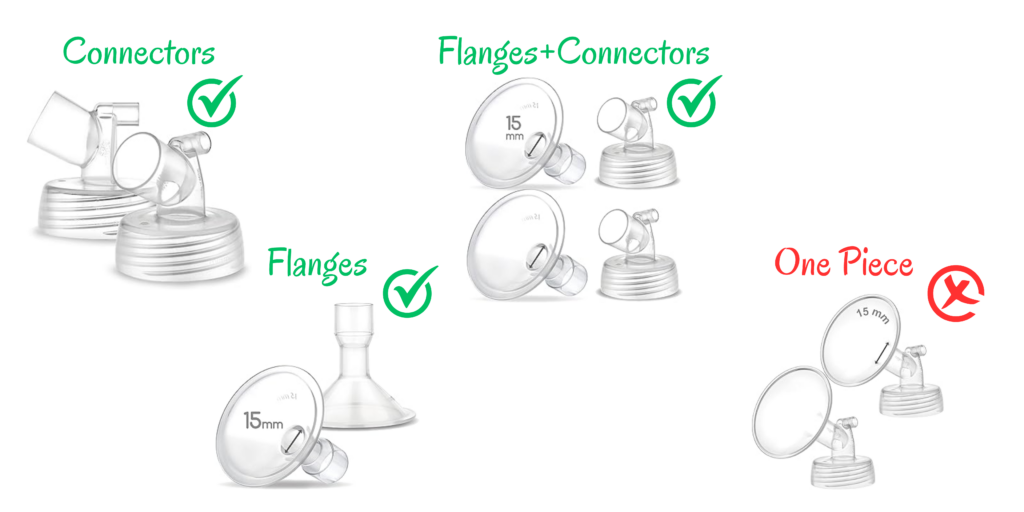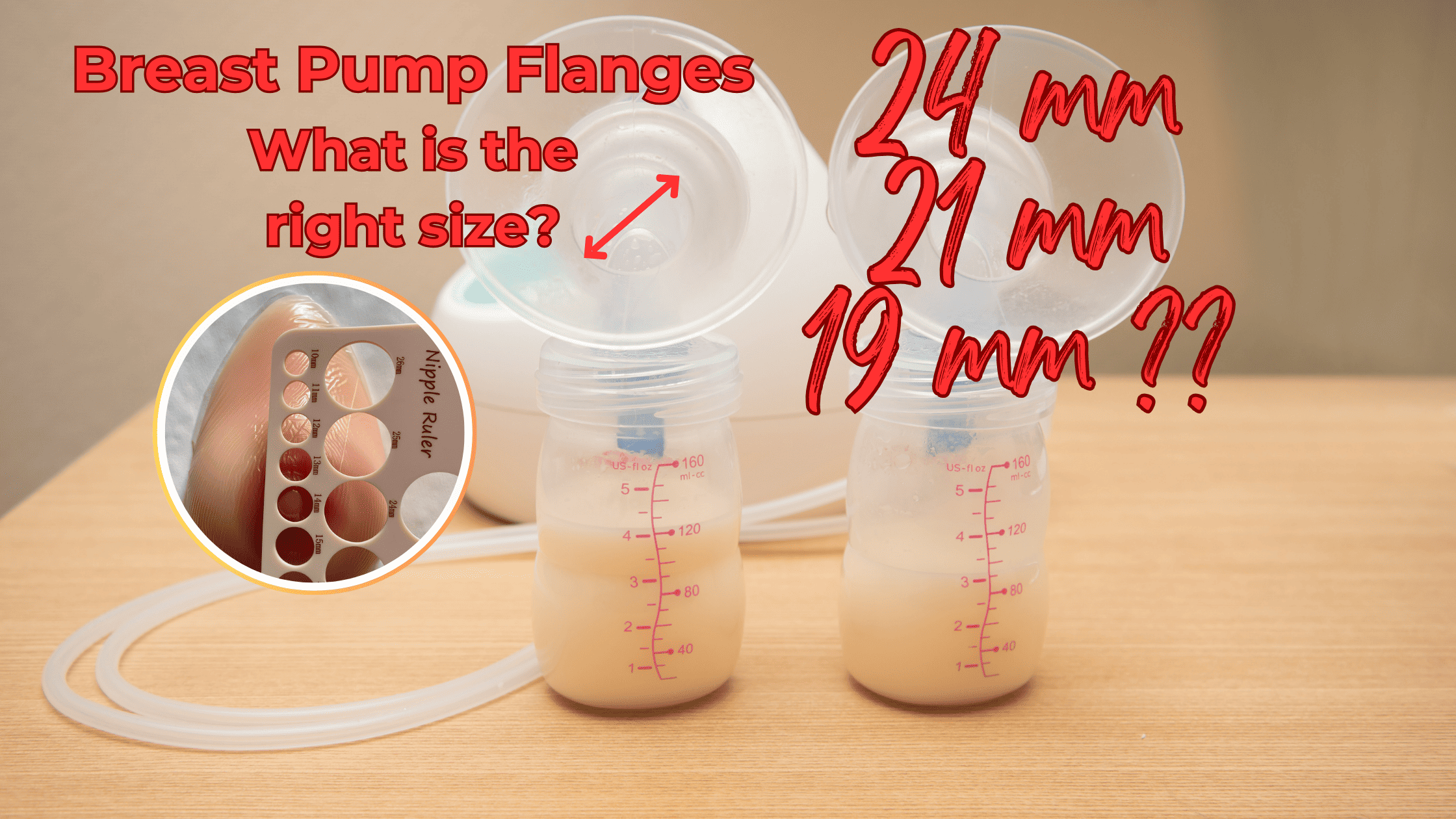Nowadays, breast pumping has become a necessity for many lactating parents.
Their main goal is to fully empty their breasts in the least amount of time!
In order to achieve these goals, moms have questions like
“Which breast pump should I use?” … “Are there any tricks to get the most”…
“Am I using the best Flange Size for my nipples?”
These are all great questions, and we will talk about them – one by one – in these new Pumping Series Blogs 😊
Today, we will focus on Flange Size!
What is a Breast Pump Flange?
In case you are not sure about what a Pump Flange is, this is the “funnel-like-shape” – part of the breast pump system – that directly attaches to the breast, creating a seal. Sometimes it is also called breast shield.
These flanges come in different sizes.
Normally the pump package includes a 24mm (Millimiters) and a second set that may vary as a 21mm or even a 27mm.
Let me ask you something…
Do you think the size of the flange is that important to effectively express breastmilk? The answer is… absolutely YES!
There have been case studies, testing the effectiveness of pumping sessions just by changing the flange size.
The results of these tests were actually very interesting since they conflicted with the previous theory.
Till not long ago – and you may still read these instructions on breast pump manuals or websites – it was told to measure the nipples size and add 2-4 mm.
What the experiments highlighted was that, when lactating women were using flanges matching their measured size, or really close to their sizes, they were expressing more milk in less time!
If we think at what happens in the baby’s mouth, it actually makes perfect sense!
Your baby is totally wrapping the nipple into their mouth, without any lag in the between. This provides maximum stimulation to your breast and nipple area!
If we look at what happens to our nipples during a pumping session this new theory makes even more sense!
While pumping, the nipple is pulled in the flange funnel – the small cylinder of the flange – with a strong suction.
If we use a bigger size, more areola is pulled in the cylinder and the nipple will swell and expand to fill up the gap. This will end up stretching the nipple skin, with consequent tenderness and soreness.
So, the way to choose your perfect, glove-like, flange is by trying a few different sizes, starting with the same size as your nipples and eventually go up – 1 mm at the time – to “feel” the difference.
Normally the winner is the matching size or just 1mm up!💪
You can get a professional flange fitting by booking an appointment with a Lactation Specialists. They offer flange fitting appointments or they may include it in any prenatal or postnatal visit.
As a side note, please be aware that if you will be measured during a prenatal visit, your numbers may not be 100% accurate since your nipples may slightly change and increase in size after giving birth and starting nursing with the new flow of hormones.
If you can’t see a Lactation Specialist, don’t worry, you can still find your – perfect fit – Flange Size in the comfort of your home!
You will want to start by measuring your nipples diameter, both sides!
It is not uncommon to have nipples in 2 different sizes… or shape.
There are some handy DIY tools that will allow you to take a pretty accurate measurement.
Here is a link to a Maymom printable measuring tool: nipple diameter caliper direct for user.cdr (maymom.com)
As mentioned above, you may have in your pump box a 24-21-27mm but in my practice, the average size I measure is between 15mm and 19mm!
I can ensure you this is a HUGE difference, and feeling! And lots of moms that went through this process, can certainly tell you that. 😄
Once you have your numbers, you can buy the most appropriate flanges.
Very few pump brands offer flanges smaller then 21mm, but you will be able to buy a flange compatible with your pump from alternative ones.
VERY IMPORTANT: Ensure the flange is compatible with your pump! The descriptions are normally pretty clear about that.
If you are using a Spectra, Motif Luna or other pumps with a similar flange system (see image below), I always suggest to buy the single flange and the connectors since we noticed that the one piece flange tends to be slightly bigger.

If you are using a wearable pump you can also buy “Flange Inserts” to match your sizes. Once again pay attention to the description since some pumps require a slightly longer (or shorter) insert.
Here you can find the link to Amazon market place to find your flange sizes, inserts and adapters/connectors
(Disclosure: I am part of the Amazon Associate Program and I may earn a small commission from qualifying purchases at no additional cost for you).
What to look for while flange fitting…
- Once you get your flanges, you want to start with your exact size flange.
- Before centering your nipple on the flange, you can use a tiny bit of natural oil to lubricate the inside of the funnel. You can find some options here according to your personal preferences.
- Start the pump as usual in stimulation mode and according to your normal setting.
- Pay attention to the feeling…
Is there any pain, too much friction or pinching sensation?
Take a peek at your nipples…
Is there any discoloration?
If so, it may be best to size up 1mm and feel the difference. - Sometimes after a few minutes into pumping, your nipples may keep growing and becoming more and more elongated during the sessions. This is normally due to the so-called “Elastic Nipples“. If this is your case, a silicone flange may be your best friend (Stick with the same mm just opt for a silicone one instead of hard plastic)!
- It is pretty common for mother to notice an earlier let down than usual and also to be able to tolerate a higher suction level.
One last note. Overtime, it is not unusual to notice your nipples getting slightly bigger during your pumping journey.
If you will start noticing a difference in the sensation while pumping, you may want to try to size up.

Hope this was helpful and enjoy your pumping journey!
Lots of Love💕
Dony your IBCLC!



